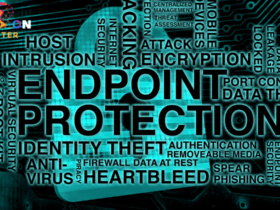Endpoint attacks are growing at an unprecedented pace. over 65% of organizations reported at least one endpoint-related intrusion. The question is no longer if attackers will strike—it’s when. That’s where the best EDR security solutions step in.
Modern Endpoint Detection and Response (EDR) platforms don’t just detect malware; they continuously monitor, analyze, and respond to sophisticated threats in real time. If your goal is complete visibility and proactive defense, adopting an advanced EDR tool is non-negotiable.
Understanding EDR Security and Why It Matters
Endpoint Detection and Response (EDR) is a cybersecurity solution designed to detect and mitigate advanced threats targeting endpoints—laptops, servers, and mobile devices.
Traditional antivirus tools rely on known signatures, but they fail against zero-day attacks and fileless malware. The best EDR security solutions combine machine learning, behavioral analytics, and threat intelligence to detect abnormal activity fast.
Key benefits of deploying EDR include:
-
Continuous monitoring for suspicious behaviors
-
Deep visibility into attack chains
-
Root cause analysis and automated remediation
-
Integration with Security Information and Event Management (SIEM) tools
In short, EDR gives security teams the power to respond before threats escalate into breaches.
Key Features of the Best EDR Security Platforms
Before diving into the top solutions, let’s review the must-have features that define a robust EDR platform:
-
Real-Time Threat Detection: Instant identification of malicious behaviors across endpoints.
-
Behavioral Analysis: Uses AI/ML models to detect deviations from normal activity.
-
Incident Response Automation: Quickly isolates compromised devices and stops threat spread.
-
Threat Hunting: Empowers analysts to proactively search for hidden threats.
-
Forensics and Reporting: Offers timeline reconstruction, root-cause insight, and audit trails.
-
Scalability: Adapts easily to enterprise networks and cloud environments.
Top 11 Best EDR Security Services
1. Xcitium EDR
Formerly known as Comodo EDR, Xcitium EDR leads the list due to its patented ZeroDwell Containment™ technology, ensuring that no threat executes on your endpoint.
Key Features:
-
Instant containment of unknown files
-
AI-based behavioral analysis and automated forensics
-
Centralized management via Xcitium Security Cloud
Best For: Mid-to-large enterprises needing fast isolation and zero false positives.
Why It Stands Out: Prevents breaches rather than merely detecting them—making it one of the best EDR security platforms available.
2. CrowdStrike Falcon
CrowdStrike Falcon remains a gold standard in endpoint threat prevention and response. Its cloud-native platform delivers exceptional visibility and rapid response.
Top Capabilities:
-
Lightweight agent with real-time telemetry
-
Threat intelligence integration
-
The Falcon Insight engine for in-depth forensics
Best For: Global enterprises and MSSPs needing advanced detection at scale.
3. SentinelOne Singularity
SentinelOne combines detection, response, and recovery through AI-powered automation.
Highlights:
-
Predictive threat analytics with storyline visualization
-
Self-healing capabilities for Windows, macOS, and Linux
-
Ransomware rollback and operational resilience
Ideal Use: Organizations seeking autonomous defense against ransomware and nation-state threats.
4. Microsoft Defender for Endpoint
Built into the Microsoft 365 security ecosystem, this EDR solution excels in integration and threat correlation.
Key Strengths:
-
Tight M365 integration for seamless workflows
-
Attack surface reduction policies
-
Advanced threat analytics and real-time response
Preferred By: Enterprises already using Azure or Microsoft environments.
5. Palo Alto Cortex XDR
Cortex XDR unifies endpoint, network, and cloud telemetry into a centralized platform.
Core Capabilities:
-
End-to-end visibility and cross-data correlation
-
Deep analytics leveraging the Palo Alto threat graph
-
Automated root cause detection and alert reduction
Best Fit: Security teams emphasizing unified visibility across IT silos.
6. Sophos Intercept X
Sophos Intercept X blends deep learning and endpoint protection in one.
Strengths:
-
Exploit prevention and anti-ransomware protection
-
Centralized threat visibility via Sophos Central
-
Deep-learning AI for zero-day attack blocking
Recommended For: SMBs and growing enterprises seeking affordable, holistic defense.
7. Trellix EDR (McAfee + FireEye)
Post-merger, Trellix offers adaptive EDR capabilities integrating behavioral analytics and FireEye threat intelligence.
Key Benefits:
-
Dynamic threat detection and containment
-
Integration with Trellix Helix for SIEM visibility
-
Advanced contextual threat response
Ideal For: Organizations needing strong forensics and response automation.
8. Cisco Secure Endpoint
Cisco’s Secure Endpoint ties EDR with its vast network security ecosystem.
Features Include:
-
Endpoint analytics fused with Cisco Talos intelligence
-
Multi-layered detection of fileless attacks
-
Retrospective alerting and advanced sandboxing
Best For: Enterprises leveraging Cisco network infrastructure.
9. Bitdefender GravityZone EDR
A powerhouse in malware prevention and endpoint control, Bitdefender uses adaptive-layered threat intelligence.
Core Features:
-
Cloud-delivered EDR with risk analytics
-
Event correlation and one-click remediation
-
Integrated patch management and hardening policies
Recommended For: Organizations prioritizing performance and minimal system impact.
10. Trend Micro Vision One
Previously called “Apex One,” Trend Micro Vision One merges EDR with XDR capabilities for unified visibility.
Key Features:
-
Risk index scoring and attack surface management
-
Cross-layer detection across endpoint, email, and cloud
-
Automation through threat intelligence feeds
Best Match: Enterprises embracing Extended Detection and Response transformation.
11. ESET PROTECT EDR
ESET delivers powerful behavioral detection with low false positives.
Highlights:
-
In-depth endpoint telemetry and sandboxing
-
Centralized investigation console
-
Lightweight agent optimized for speed and accuracy
Best Suited For: Businesses focused on stability, simplicity, and accuracy.
How to Choose the Right EDR Security for Your Organization
Choosing the best EDR security solution depends on your infrastructure, staff capability, and threat surface.
Consider These Factors:
-
Deployment Needs: Cloud or on-premise?
-
Operational Complexity: Can your team manage advanced analytics?
-
Integration: Compatibility with SIEM, SOAR, and firewalls.
-
Cost: Assess total cost, including licenses, training, and support.
-
Compliance: Ensure it meets regulatory standards (HIPAA, GDPR, etc.).
A clear risk assessment matrix helps align your EDR choice with business objectives.
Future of Endpoint Detection and Response
EDR is increasingly merging into Extended Detection and Response (XDR) ecosystems. Future-ready solutions will emphasize:
-
AI-Driven Threat Correlation: Autonomous detection with minimal analyst input.
-
Zero Trust Integration: Continuous validation of devices and identities.
-
Cloud-Native Defense Models: Protection that spans hybrid and remote work setups.
The convergence of EDR, SOAR, and Threat Intelligence platforms will shape resilient and adaptive security postures.
Comparison Table: Top 11 Best EDR Security Platforms
| EDR Solution | Key Strengths / Unique Features | Deployment Model | Best For / Ideal Use Case |
|---|---|---|---|
| Xcitium EDR | ZeroDwell Containment, extremely low false positives, rapid isolation | Cloud / On-Prem | Enterprises needing quick isolation |
| CrowdStrike Falcon | Real-time telemetry, integrated threat Intel, lightweight agent | Cloud-native | Large orgs, rapid scale |
| SentinelOne Singularity | Autonomous AI defense, ransomware rollback, storylining | Cloud/On-Prem | Automated defense, rollbacks |
| Microsoft Defender | Deep M365/Azure integration, attack surface reduction | Integrated/Cloud | MS-focused enterprises |
| Palo Alto Cortex XDR | Cross-layer detection, powerful analytics, root cause tracing | Cloud | Enterprises needing unified visibility |
| Sophos Intercept X | Deep learning AI, exploit prevention, centralized management | Cloud/On-Prem | SMBs and blended protection |
| Trellix EDR (McAfee/FireEye) | Adaptive EDR, contextual analysis, advanced forensics | Cloud / Appliance | Enterprises with need for advanced analytics |
| Cisco Secure Endpoint | Talos threat intelligence, layered fileless detection, strong integration | Cloud | Cisco-centric infrastructure |
| Bitdefender GravityZone | Layered intelligence, patch management, low footprint | Cloud / Hybrid | Minimal system impact, performance-focused |
| Trend Micro Vision One | Integrated XDR, risk indexing, threat automation | Cloud/Hybrid | Cross-layer, extended detection |
| ESET PROTECT | Efficient behavioral detection, minimal false positives | Cloud / On-Prem | Simplicity, fast lightweight agents |
-
Key Strengths: Summarizes what the vendor is known for or what unique advantages are frequently cited in expert and industry reviews.
-
Deployment Model: Indicates if the solution is available via cloud, on-premises, or both, supporting varied compliance and infrastructure needs.
-
Best Use Case: Highlights where each platform excels, allowing organizations to match to their environment and security maturity.
Final Thoughts: Building a Resilient Endpoint Security Strategy
Investing in the best EDR security platform is more than a compliance measure—it’s a commitment to operational stability. Endpoints remain prime targets, and staying ahead means using predictive defense, automated response, and round-the-clock visibility.
When threats evolve every minute, your defenses must adapt even faster. Choose a platform that aligns with your business maturity, integrates smoothly, and provides transparent protection—from detection to recovery.
Frequently Asked Questions (FAQs)
1. What is EDR in cybersecurity?
EDR (Endpoint Detection and Response) monitors and analyzes endpoint activity to detect, investigate, and respond to cyber threats proactively.
2. How does EDR differ from antivirus software?
While antivirus protects against known threats, EDR detects unknown or fileless attacks through behavioral analytics and real-time monitoring.
3. What are examples of the best EDR security tools?
Top solutions include Xcitium EDR, CrowdStrike Falcon, SentinelOne, and Palo Alto Cortex XDR.
4. Why do companies need EDR?
Because 80% of targeted attacks originate from compromised endpoints. EDR ensures quick detection and response before attackers cause damage.
5. Is EDR suitable for small businesses?
Yes. Lightweight solutions like Sophos Intercept X or ESET PROTECT offer strong protection with minimal IT overhead.
6. How is EDR different from XDR?
EDR focuses on endpoint threats, while XDR unifies detection across endpoints, networks, emails, and cloud workloads.
7. What’s the most important EDR feature to look for?
Prioritize automated response, behavioral analytics, and threat intelligence integration.
8. What’s the future of EDR security?
Next-gen EDR will rely on AI-driven decision-making, cross-platform telemetry, and autonomous response capabilities.













Leave a Reply
View Comments